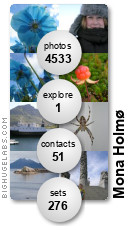Some of my interests include history and linguistics, and since I was a child I was fascinated by the viking era and its influence on the western world. They were often descibed as villains, but they were also farmers, skilled craftsmen building beautiful longboats, navigators and explorers.
As a kid I used to search the Atlas for Norwegian words in other countries placenames, and found quite a few on the British Isles. The other day I read a text in the Norwegian book "Typisk norsk", ed. by Petter Schjerven, showing the influence the norsemen had on the English tongue. Here it is, remarkable isn't it?
You cannot
hit (hitta) or
scare (skirra) anyone, or
scream (skræma),
scowl (skúla) or
die (deyda) without using Scandinavian verbs, nor can a
fellow (félagi) or a
husband (húsbòndi) look in
anger (angr) through the
window (vindauga) at the sky without using Scandinavian nouns. You cannot do without essential pronouns like
they (þeir),
their (þeira) and
them (þeim), not to speak of
both (báðir) and the
same (sami), nor can any Englishman do without a descriptive inventory of adjectives which includes not only
odd (oddi),
ugly (uggligr),
ill (illr),
wrong (vrangr) and
scant (skamt), but also
happy (heppin),
meek (mjúkr) and
low (lágr).
Talking about vikings, you know the helms with horns on them, they had nothing to do with vikings! They have found more than 10000 items of weapons (swords, axes, shields), and more than this of clothing from the viking era in Scandinavia. They have found one - 1 - helmet, and this one didn't have horns on it. So most vikings probably didn't use helmets at all, and if they wore any helmets they were probably made of leather.
They have found a tapestry where the rider in front of a procession wore a helmet with someting looking like horns, and they have found small figurines with horn helmets. These probably represent the Gods - meaning; the Gods used helmets like these, but never man. It would probably be too inconvenient using helmets in the man-to-man swordfights they used to have.
The horn helmet myth started most likely back in 1876, at the opera! The Richard Wagner grand opera Nibelungringen needed a big scale sceneography, and the operasingers were equipped with horn helmets. So when people try to look like vikings today, they dress up like operasingers!! ;)
 I'm currently on sabbatical leave from my position as executive director of the Sciencenter, a hands-on science museum in Ithaca, New York. From July thru October 2007, I will be visiting a series of European museums to assess how they view their role in bringing environmental concerns to their audience.
I'm currently on sabbatical leave from my position as executive director of the Sciencenter, a hands-on science museum in Ithaca, New York. From July thru October 2007, I will be visiting a series of European museums to assess how they view their role in bringing environmental concerns to their audience. 








